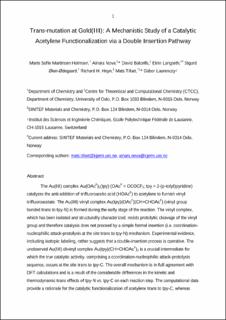| dc.contributor.author | Holmsen, Marte Sofie | |
| dc.contributor.author | Nova, Ainara | |
| dc.contributor.author | Balcells, David | |
| dc.contributor.author | Langseth, Eirin | |
| dc.contributor.author | Øien-Ødegaard, Sigurd | |
| dc.contributor.author | Heyn, Richard H. | |
| dc.contributor.author | Tilset, Mats | |
| dc.contributor.author | Laurenczy, Gábor | |
| dc.date.accessioned | 2020-12-21T12:29:51Z | |
| dc.date.available | 2020-12-21T12:29:51Z | |
| dc.date.created | 2017-09-12T10:26:12Z | |
| dc.date.issued | 2017 | |
| dc.identifier.citation | ACS Catalysis. 2017, 7 (8), 5023-5034. | en_US |
| dc.identifier.issn | 2155-5435 | |
| dc.identifier.uri | https://hdl.handle.net/11250/2720582 | |
| dc.description.abstract | The Au(III) complex Au(tpy)(OAcF)2 (OAcF = OCOCF3; tpy = 2-(p-tolyl)pyridine) catalyzes the anti addition of trifluoroacetic acid (HOAcF) to acetylene to furnish vinyl trifluoroacetate. The Au(III) vinyl complex Au(tpy)(OAcF)(CH═CHOAcF) (vinyl group bonded trans to tpy-N) is formed during the early stage of the reaction. The vinyl complex, which has been isolated and structurally characterized, resists protolytic cleavage of the vinyl group, and therefore catalysis does not proceed by a simple formal insertion (i.e., coordination-nucleophilic attack-protolysis at the site trans to tpy-N) mechanism. Experimental evidence, including isotopic labeling, rather suggests that a double-insertion process is operative. The unobserved Au(III) divinyl complex Au(tpy)(CH═CHOAcF)2 is a crucial intermediate for which the true catalytic activity, comprising a coordination-nucleophilic attack-protolysis sequence, occurs at the site trans to tpy-C. The overall mechanism is in full agreement with DFT calculations and is a result of the considerable differences in the kinetic and thermodynamic trans effects of tpy-N versus tpy-C on each reaction step. The computational data provide a rationale for the catalytic functionalization of acetylene trans to tpy-C, whereas ethylene (previously reported) only undergoes a stoichiometric insertion, and then comes to a full stop, trans to tpy-N. | en_US |
| dc.language.iso | eng | en_US |
| dc.publisher | ACS Publications | en_US |
| dc.subject | Catalysis | en_US |
| dc.subject | Vinyl | en_US |
| dc.subject | Bond cleavage | en_US |
| dc.subject | Ligands | en_US |
| dc.subject | Hydrocarbons | en_US |
| dc.title | trans-Mutation at Gold(III): A mechanistic study of a catalytic acetylene functionalization via a double insertion pathway | en_US |
| dc.type | Peer reviewed | en_US |
| dc.type | Journal article | en_US |
| dc.description.version | submittedVersion | en_US |
| dc.rights.holder | This document is the Accepted Manuscript version of a Published Work that appeared in final form in
ACS Catalysis, copyright © American Chemical Society after peer review and technical editing by the publisher.
To access the final edited and published work see [insert ACS Articles on Request author-directed link to
Published Work, see https://pubs.acs.org/doi/10.1021/acscatal.7b01364 | en_US |
| dc.source.pagenumber | 5023-5034 | en_US |
| dc.source.volume | 7 | en_US |
| dc.source.journal | ACS Catalysis | en_US |
| dc.source.issue | 8 | en_US |
| dc.identifier.doi | 10.1021/acscatal.7b01364 | |
| dc.identifier.cristin | 1492903 | |
| dc.relation.project | Norges forskningsråd: 221801 | en_US |
| dc.relation.project | Norges forskningsråd: 179568 | en_US |
| dc.relation.project | Notur/NorStore: NN4654K | en_US |
| cristin.unitcode | 7401,80,6,7 | |
| cristin.unitcode | 7401,80,5,4 | |
| cristin.unitname | Nano-og hybridmaterialer | |
| cristin.unitname | Prosessintensivering og katalyse | |
| cristin.ispublished | true | |
| cristin.fulltext | preprint | |
| cristin.qualitycode | 1 | |
